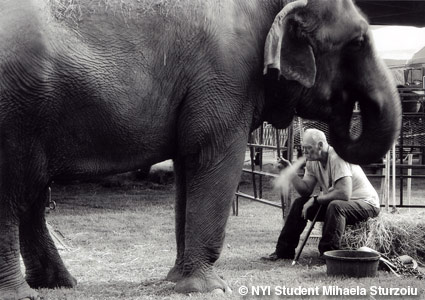Want a picture-taking challenge? Well, if you are a parent, grandparent, or relative of a toddler and you are the “designated photographer”, you already know that capturing kids of this age with a camera is downright difficult. Why? Simply because toddlers often exhibit non-stop motion, have the attention span of about a nanosecond, and can emotionally range from hysterical laughter to hysterical crying, sometimes for no apparent reason.

However, I have always found this age group to be more rewarding, photography-wise, than children of any other age. Infants, of course, have their own charm and most people think babies are adorable. Maybe so, but in my experience toddlers are more interesting. They are at the age when they are really able to interact with the world around them, walking (or running) everywhere and touching everything. You can talk to them and get a meaningful response, though sometimes it’s not one we would prefer. Every parent knows that one of the easiest words they learn to articulate is NO. But photographing them is action photography by definition, more akin to sports than portraiture, and that’s where the challenge lies.
How to do it? Well, in my experience it is pointless to try to pose a toddler in any formal sense. There may be some two or three year olds who will sit still for that but I’ve rarely met one. Younger than two ñ forget it (I’m defining toddler age as ranging roughly from one to three). I think the best approach is to involve the child in some sort of activity that will produce good reaction shots. That can be almost anything. For example, in the home you have the kid’s toys but something as simple as a small ball makes a great prop. I’m talking about a child version of “go fetch” that dogs seem to like. Roll it across the floor or bounce it and there’s not a toddler alive that won’t run to retrieve it or try to catch it.


Got a musical instrument? An electric keyboard can fascinate a child for hours, especially the ones equipped with a variety of pre-recorded musical sounds. You’ll probably want to keep their hands off your Stradivarius but keyboards can be acquired without having access to a trust fund and are a great way to introduce a child to music. For the photographer they provide us with a subject that is not running all over the place, making it easier to compose, focus, and shoot.
How about the kitchen? Naturally you'll want to keep them away from a hot stove or sharp utensils but there probably are other things of interest. For example, my granddaughter loves to “help” load our dishwasher and that presents no hazards (with supervision, of course). But I had to teach her not to touch our cat while Kelly was eating, the kitchen being where this occurred.
Speaking of pets, they can be great “props” though you'll have to closely supervise this, especially if the pet is a cat. Little kids have to learn that “Fuffy” doesn't like to have her tail pulled. Dogs tend to be a bit more tolerant but that will depend on the dog.
Word games can be a lot of fun. One of my favorites is a certain nonsense word featured in the film, Mary Poppins. In case you never saw the movie (is that possible?), the word is “supercalifragilisticexpialidocious”. Ask your two or three-year old to repeat it and watch the facial expressions.


However, ordinary daily routines around the home can provide good photo opportunities. And be alert for the unexpected.
Ok, if you are a parent you already know all this stuff. We learn it from our children, as kids are great “teachers”. But how do you get good pictures? For most people that means questions about what camera and lens, flash or natural light, digital or film (nowadays this particular question is no longer relevant — it's digital by a wide margin), exposure, and other technical considerations. Well, it might surprise you to learn that the technical aspect is the least important one you face. (What's the most important? That's easy — knowing how to handle, interact with, and inspire kids). However, the vast number of questions I fielded when I was a Student Advisor related to the technical stuff so let's get into that.
The best camera is any modern digital SLR with a decent zoom lens. I personally prefer fixed-focal length lenses, usually called “primes”, but for most folks, a good zoom with focal lengths ranging from short to moderately long is a better choice.
If your camera, however, is a typical point-and-shoot type, you'll have great difficulty capturing toddlers because of the shutter lag. By the time the camera takes the picture, the action is over with. Now is a good time to upgrade, especially considering the relatively low price of DSLR’s today.

What about lighting? For the older children, natural window light can provide nice illumination but not for toddlers, at least when they are moving. Flash is a better choice because its short duration will tend to freeze any motion. And flash allows you to use a lower ISO setting on the camera, thus reducing or eliminating noise. But I don't mean direct flash with the one built into your camera. I mean flash off the camera, usually bounced off the ceiling, a wall, or sometimes a white board. Furthermore, flash bounced off the ceiling gives you broad coverage, important when that kid is moving all over the place. A hotshoe-type flash that tilts can be used effectively for bounce lighting but a flash off the camera entirely gives you more flexibility. Here's an article I wrote a while back that goes into off-camera flash in some detail. It was written for budget-minded people with digital point-and-shoot cameras but is entirely applicable to DSLR's.
By the way, optical slaves such as I mention in the article have one limitation. If you are photographing your toddler at an event like a birthday party and other people are popping their flashes, be aware that every time one goes off, your slaved flash will too. You can prevent this by covering the slave sensor with your hand when not actually taking pictures. Another option is to use a radio slave. They employ radio frequencies to communicate between the transmitter, typically attached to the camera's hotshot, and the receiver attached to the strobe. But this option will involve an expense you might not be willing to embrace. A Pocket Wizard set-up, popular with many pros, might cost more than your camera and lens.
Shooting with flash also means forgetting about burst mode. Your flash needs time to recycle so you'll want to pick your shots, anticipate the action, and then shoot.
Of course, shooting outdoors eliminates the necessity of using strobes, though you'll want to provide some fill-flash if it's sunny. Your camera's pop-up flash might be good enough for this provided you can control its output. If so, set it for -1 or -1/1/2 EV for fill. But watch out for red-eye if the child is looking at the camera. Red-eye can be dealt with by setting the flash for whatever red-eye reduction feature it has. Personally, I prefer to fix any red-eye with post-capture software.
Try to pick a day that is bright but hazy. The shadows will be softer, hence eliminating the need for any fill-flash. This is important when photographing action, like a toddler in motion, since you won't have to worry about your camera's flash sync speed being too slow.
Focus mode? Well, autofocus can work well, especially if it’s continuous or predictive. But autofocus can be fooled, particularly if your depth of field is narrow. Then too, be aware that the autofocus sensor on your camera may cover a wider area than you think. Focusing on your subject's eyes is standard portrait procedure but with autofocus, you might wind up with sharp ears (or even something sharp in the background) but out of focus eyes. Know your camera. By the way, the illustrations accompanying this article were all shot in autofocus mode, mainly because my aging eyesight has come to rely on it. But I sometimes use manual focus too.


If your camera is equipped with Live View, you might consider framing your subject with that rather than the optical viewfinder. Why? Because you can communicate more effectively with the child when the camera is not mashed against your face. If your camera lacks this feature, try first framing and focusing the usual way, then move your head a little to the side so the child can see your face. It takes some practice and you’ll want to compose with extra room around your subject to allow for cropping and fixing any framing errors. But it's worthwhile to learn how to shoot this way. Of course, it's easy if your camera is on a tripod and I highly recommend one whenever feasible.
Also, this technique works well if you want your child to look at the camera. Instead of saying “look at the camera”, simply talk to the child while framing your shots. The child will look at you but in the resulting photo will appear to be looking out at the viewer. It's an old portrait photographer's trick. By the way, a useful device to get a toddler's attention is the kind of squeaky toy they sell in pet stores. I guess they are intended for dogs but work very well with small children. And the kids love squeezing them.
How should you set your camera for the exposure? Well, I strongly recommend shooting RAW. It gives you more options, post-capture, than JPEG. I also advise against using “scene modes”, if your camera has them. Again, more control is the ticket here so use manual exposure. You'll need to do that anyway if your off-camera flash is not dedicated to your camera.
Backdrops? That's up to you. I don't use them, except when I photograph older children and adults indoors. But shooting with the home environment in the background requires that you be alert to what’s back there. Our home is somewhat cluttered so I have to be especially vigilant. Watch out for mirrors and sunny windows in the background. The latter might result in distracting highlights in the photo.
By the way, it helps to have an assistant to help during the photo sessions. My “assistant” while taking pictures of my granddaughter (my favorite subject nowadays) is my wife. That's her in some of the images accompanying this article.
Finally, take LOTS of pictures. For that you'll want to be sure the batteries for camera and flash are fully charged. Consider getting a larger memory card, especially if you are shooting RAW. That means at least 2Gb, maybe more. And be alert to when picture time is over, typically when it's close to nap or meal time. Your subject will usually express that quite clearly so don't press it with “just one more”. There'll be other chances.
Learn more great photography trick and be ready for whatever your toddler can throw at you with our online photography course.






